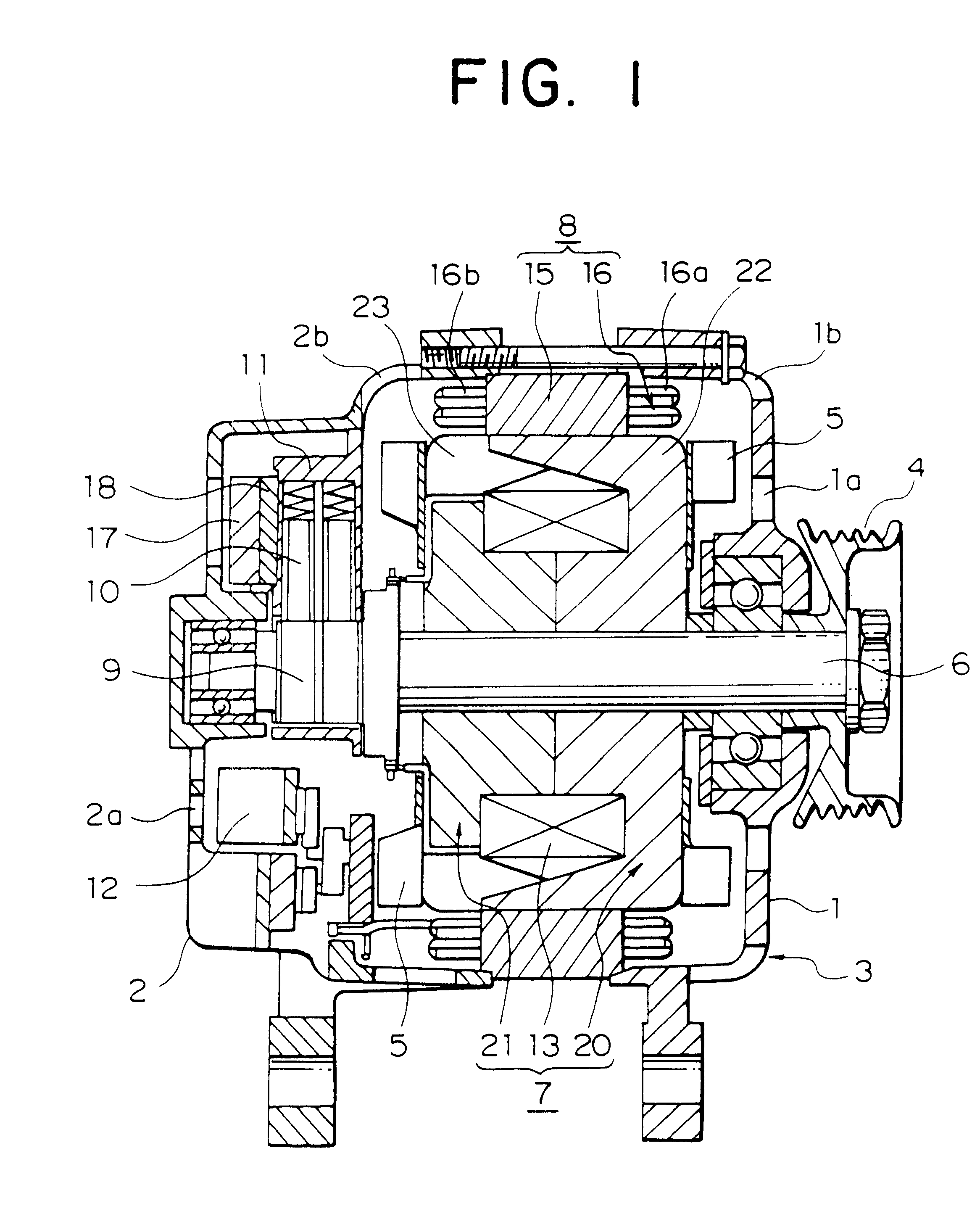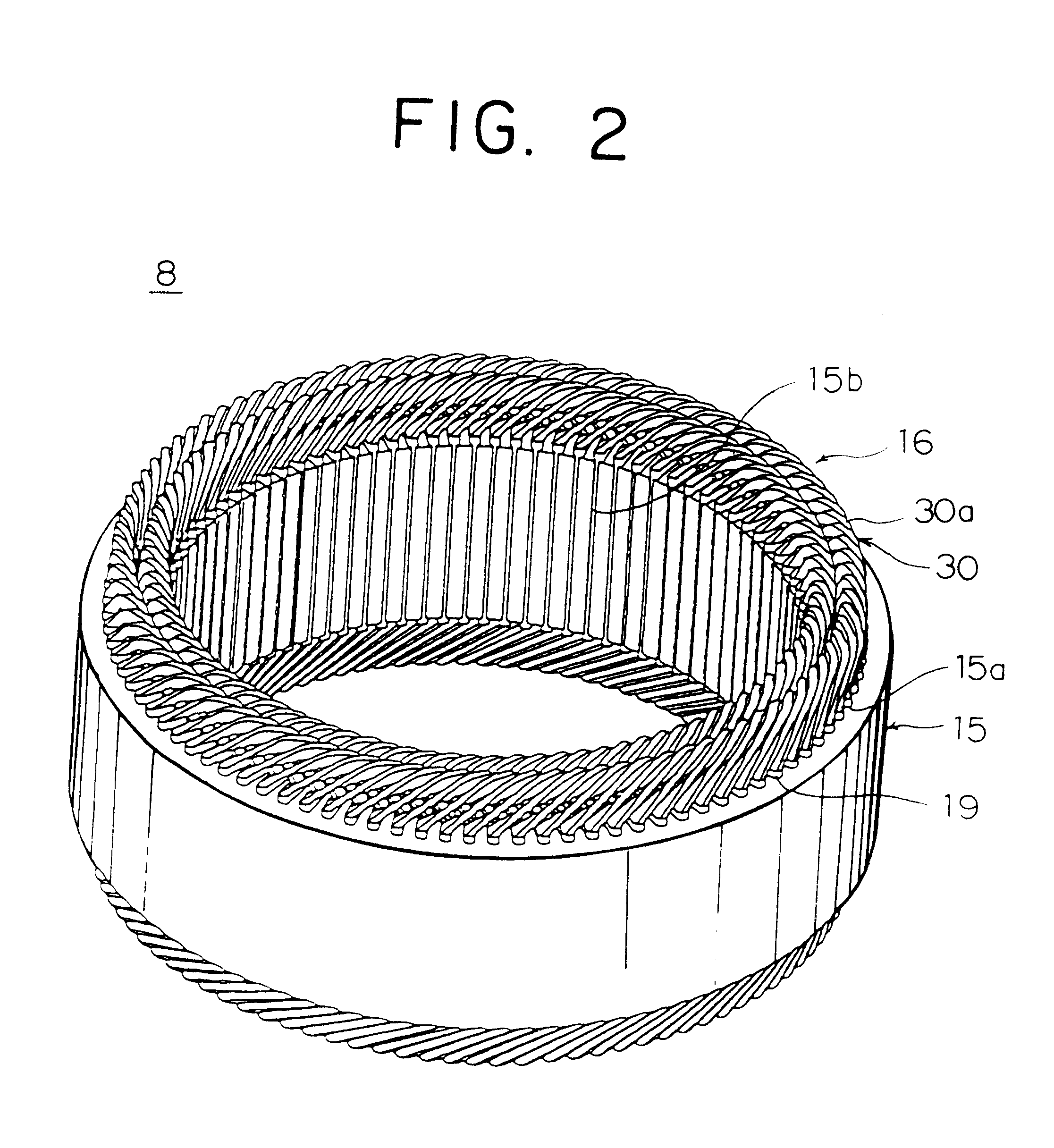Alternator
a technology of alternators and rotating parts, applied in the field of alternators, can solve problems such as significant decrease of operability, deterioration of output, and deterioration of outpu
- Summary
- Abstract
- Description
- Claims
- Application Information
AI Technical Summary
Problems solved by technology
Method used
Image
Examples
embodiment 1
FIG. 1 is a cross section showing a construction of an automotive alternator of the present invention, FIG. 2 is a perspective showing a stator of this automotive alternator, FIG. 3 is an end elevation explaining connections in one stator coil phase portion in this automotive alternator, FIG. 4 is a circuit diagram for this automotive alternator, FIGS. 5 and 6 are diagrams explaining the manufacturing process for wire-strand groups constituting part of the stator coil used in this automotive alternator, FIGS. 7A and 7B are an end elevation and a plan, respectively, showing an inner-layer wire-strand group constituting part of the stator coil used in this automotive alternator, FIGS. 8A and 8B are an end elevation and a plan, respectively, showing an outer-layer wire-strand group constituting part of the stator coil used in this automotive alternator, FIG. 9 is a perspective showing part of a strand of wire constituting part of the stator coil used in this automotive alternator, FIG...
embodiment 2
In Embodiment 2 of the present invention, because the phase difference between the phases in each of the three-phase coils 160 does not change, there is no decrease in output. Furthermore, because the two three-phase coils 160 are disposed so as to have a mutual phase difference corresponding to an electrical angle of (60-.alpha.).degree. and the circumferential air-gap centers of the adjacent slot opening portions 15b have a non-uniform pitch so as to alternate between an electrical angle of .alpha..degree. and an electrical angle of (60-.alpha.).degree., the higher harmonic components of the magnetomotive force which are the cause of electromagnetic noise can be reduced. Thus, by using the construction of Embodiment 2 of the present invention, a sufficient level of noise reduction can be achieved even in an automotive alternator having compactness and high output where magnetic noise is promoted by an increased number of claw-shaped magnetic poles and slots.
Furthermore, by changin...
embodiment 3
In Embodiment 3, as shown in FIG. 17, by adjusting a circumferential width of the teeth 15c, circumferential air-gap centers of adjacent slot opening portions 15b are disposed at a non-uniform pitch so as to alternate between an electrical angle of .alpha..degree. and an electrical angle of (60-.alpha.).degree.. Thus, the circumferential air-gap centers of the slots 15a are arranged so as to alternate between an electrical angle of .alpha..degree. and an electrical angle of (60-.alpha.).degree.. Thus, .alpha..noteq.30.
Moreover, the rest of the construction is the same as in Embodiment 2 above.
In Embodiment 3, because the pitch between the circumferential air-gap centers of the adjacent slots 15a is arranged so as to alternate between an electrical angle of .alpha..degree. and (60-.alpha.).degree., the phase difference between the phases in each of the three-phase coils 160 does not change. Furthermore, the two three-phase coils 160 are arranged so as to have a mutual phase differenc...
PUM
 Login to View More
Login to View More Abstract
Description
Claims
Application Information
 Login to View More
Login to View More - R&D
- Intellectual Property
- Life Sciences
- Materials
- Tech Scout
- Unparalleled Data Quality
- Higher Quality Content
- 60% Fewer Hallucinations
Browse by: Latest US Patents, China's latest patents, Technical Efficacy Thesaurus, Application Domain, Technology Topic, Popular Technical Reports.
© 2025 PatSnap. All rights reserved.Legal|Privacy policy|Modern Slavery Act Transparency Statement|Sitemap|About US| Contact US: help@patsnap.com



